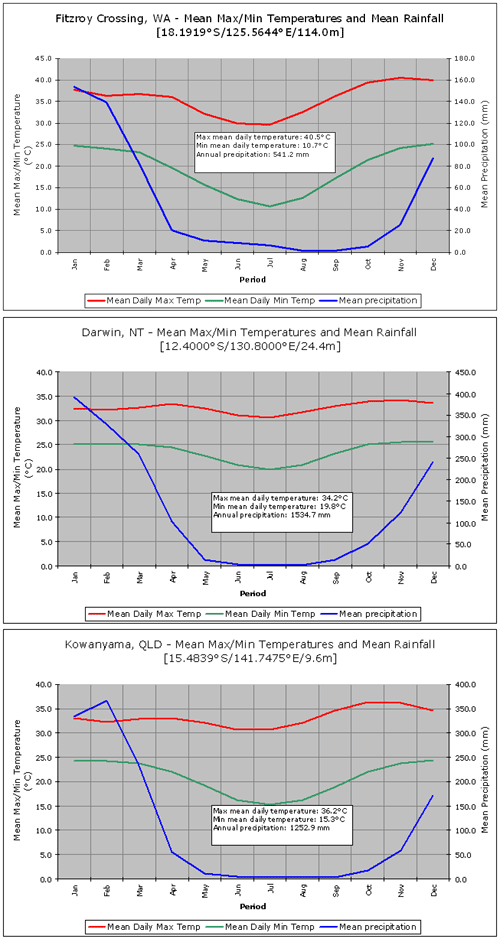Northern Yellow-faced Turtle -- Emydura tanybaraga
[3]

Diet
Virtually nothing has been published on this species
diet and feeding behaviour. It is highly probably E. tanybaraga
is an opportunistic omnivore, just like other Northern Emydura
species. Juveniles may show carnivorous tendencies. Both Eric Worrell (1945 and 1946)
and John Legler (1976) studied the diet of Northern Emydura species
and concluded their diet consists of mussels, small molluscs, snails and
vegetable matter including Pandanus fruits. Emydura tanybaraga
aged females may be subject to megacephaly, which is a diet thought to be
related character.
Right graphs: Mean max/min temperatures and mean precipitation for 3 regions
inhabited by Emydura tanybaraga. From top: Fitzroy River, WA; Finniss
River, NT; Mitchell River, QLD
Breeding
No information has been published on the species breeding
biology. Some partial information, which has been originally published on
sister species Emydura victoriae by Smith and Wood and Emydura
australis by John Legler, was later thought to be related to Emydura
tanybaraga (Cann, 1998). Legler (1981) states nesting occurs from August
to mid November. Hatching occurs in late October (Smith and Wood, 1985)
and possibly lasts through November with the arrival of the first rain. The breeding cycle, which consists of mating, laying and hatching, may vary between the three populations and is probably adjusted to the climate. Natural timing is necessary so that hatching begins with the first rains in order to increase the survival chances of hachlings.
One nest examined by Smith and Wood, which was found to be located approximately three meters
away from the water and 1.5 m above the water level, contained about 16-17
eggs (Smith and Wood, 1985). Smith and Wood also provided some hatchlings
mean data:
Weight: 5.73 g
Carapace length: 316 mm
Carapace width: 287 mm
Head width: 99 mm
(See Cann 1998 for more details)
In captivity
Emydura tanybaraga is not common in captivity. In fact, with a very few exceptions, only Australian institutions (i.e. zoological gardens or universities) can claim this species is part of their collections. Being a tropical species, its captive husbandry should not differ from that of its sister species Emydura subglobosa subglobosa, a common short-necked turtle kept and bred worldwide. Taking in account the conditions in the habitat the species occupies, I would propose to keep it in water with the temperature of 25 - 28°C and pH around 7.5. Both animal and plant matter should be fed. If one wants to keep Emydura tanybaraga with any other Testudines species, I would strongly recommend choosing a tropical species out of the Australasian Chelidae, preferably species that are sympatric to E. tanybaraga.
